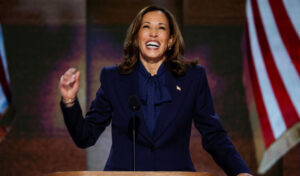When Donald Trump and Kamala Harris step into the ring this evening, America will be treated to an illusion. For the past month, we’ve been told that tonight’s showdown in Pennsylvania will be pivotal — that, finally, the nation will witness the chosen tribunes of its two parties slugging it out for the presidency.
But appearances can be misleading. Yes, there is something called the Democratic Party and something called the Republican Party. But these entities bear little resemblance to the grassroots, mass-membership party federations that existed half a century ago. Rather, today’s organisations are made up of various groups as different from each other as from those across the aisle.
In the early decades of the American Republic, political parties were widely viewed as corrupt factions incompatible with the public interest. Yet because the US inherited the first-past-the-post-electoral system from Britain, the number of major parties had been whittled down to just two by the time of the Civil War: the Republican anti-slavery party, and the slave-holding Democrats in the Southern states.
Since then, the names of both organisations have remained the same. But until the late 20th century, they described loose, often incoherent alliances of regional power blocs. For much of the last century for instance, the Democrats were a ramshackle coalition of anti-labour Southern segregationists, northern labour union members, rural populists, and metropolitan, professional-class reformers. Meanwhile, the Republican Party was made up of liberal Republicans such as Nelson Rockefeller and conservatives such as Barry Goldwater.
Until the Seventies, conventions continued to play a central role in bringing party groups together. Delegates were considered ambassadors from around the country, representing both local political machines and rural courthouse gangs. To secure the nomination, the winning candidate had to make concessions to these various party factions, even if it meant choosing a running mate from a different wing of the party.
All of this, however, is now ancient history, in no small part thanks to two structural changes: the rise of party primaries and the deregulation of campaign finance.
In the decades since the Seventies, reformers in both parties introduced the primary process in the hope of democratising an antiquated system in which cigar-chomping state and local bosses picked candidates in smoke-filled rooms between ballots at party conventions. But the replacement didn’t work out that way. Instead, candidates are now picked in primaries, and a few caucuses, in which only small, unrepresentative shares of the eligible electorate bother to vote. In 2016 and 2020, 15% of eligible voters participated in the party primaries that selected the presidential candidates. This year, roughly 10% of eligible selected Donald Trump and Joe Biden.
What’s more, in both parties, each small group of selectors was neither representative of their own party’s voters nor the American population as a whole. Both Democratic and Republican primary voters are more likely than voters in general to have college degrees and to have completed postgraduate study; they also have considerably higher household incomes.
As a result, there has been a shift in power from state and local party bosses, who were at least somewhat accountable to local working-class voters, to upper-middle class and rich primary voters, who vote on the basis of their values and material interests. Relatively cushioned from monthly struggles to pay the bills, these voters tend to be motivated more by culture-war issues than the rest of the electorate. For instance, while abortion dominated the Democratic primary, only one in eight voters considers it their most important issue, with most Democrats naming health care costs, the economy, and education as a priority.
Meanwhile, as the adoption of the primary system reduced the pool of voters selecting candidates, the deregulation of campaign finance all but severed the link between local communities and the politicians who purport to represent them. This crystallised in 2010, when the Supreme Court’s effective deregulation of campaign finances allowed so-called “dark money” groups to spend unlimited amounts from undisclosed donors on behalf of parties and candidates, as long as they pretended not to be affiliated with them. These donors didn’t hang around. Between 2012 and 2022, the amount spent by these groups rose from $50 million to $653 million.
Money, of course, has always been necessary for parties and individual candidates wishing to plant their platforms before the public. Decades ago, it was common practice for Democratic politicians in Texas to seek the support of the oil and gas industry and the rich families and businesses in their cities or counties. Yet now, a handful of Democratic and Republican megadonors who live in a few cities, along with corporate and non-profit lobbies, can pressure candidates even in state and local races to promote their agendas — to the extent that America’s parties are little more than fronts.
And this partly explains why American politics is more polarised than ever. Unlike the pragmatic party bosses of the past, primary voters tend to be purists who view compromise as betrayal and would rather lose elections than surrender their principles. For their part, the megadonors who flood both parties with money are less interested in political victory than in imposing their personal views — on climate change and gender ideology if they are progressives, or on tax cuts and Social Security cuts if, like most Republican donors, they are libertarians.
The result is perhaps unsurprising, with an increasing number of American voters left without a political home. Last year, 43% described themselves as independents — a group nearly twice as large as self-described Republicans and Democrats. These independents do not share common values or views. They include libertarians who combine free-market economics with support for drug legalisation and populists who are Left-wing on economic policy but conservative on social issues.
What they have in common, however, is the sense that they’ve been betrayed by the American political system — a system that hides the reality of oligarchic domination behind the façade of old-fashioned representative democracy. When Trump and Harris take to the debate stage, their suspicions will only be confirmed.
Disclaimer
Some of the posts we share are controversial and we do not necessarily agree with them in the whole extend. Sometimes we agree with the content or part of it but we do not agree with the narration or language. Nevertheless we find them somehow interesting, valuable and/or informative or we share them, because we strongly believe in freedom of speech, free press and journalism. We strongly encourage you to have a critical approach to all the content, do your own research and analysis to build your own opinion.
We would be glad to have your feedback.
Source: UnHerd Read the original article here: https://unherd.com/




